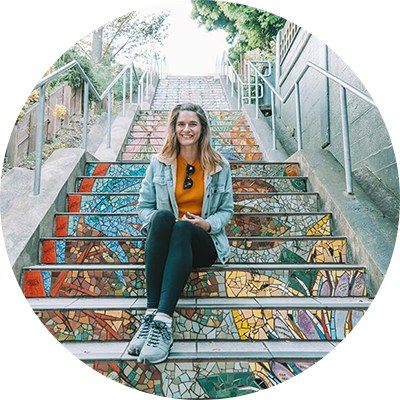Experience San Francisco’s iconic landmark by walking the Golden Gate Bridge.
With its elegant curves, striking International Orange color, and ambitious construction, San Francisco‘s Golden Gate Bridge has always been far more than a connection between two Bay Area counties.
The iconic bridge stands as a symbol of San Francisco’s technological and artistic accomplishments.
The architect selected the orange paint to contrast beautifully with the blue ocean, while the chief engineer pushed the limits of what was possible and designed the tallest and longest suspension bridge ever built (at the time).
Although there are many viewpoints from which to admire this architectural stunner, there’s no better way to appreciate the span than walking the Golden Gate Bridge yourself.
People walk the bridge to feel the vibrations from the traffic, listen to the wind as it whistles through the cables, and glimpse the art deco details you can’t see from the vista points.
Whether you’re planning a there-and-back hike or a one-way mid-morning stroll, my guide to walking the Golden Gate Bridge has everything you need to know, including what to bring, to trek across San Francisco’s famous bridge.
Note: this post contains affiliate links, which help run this site at no extra cost to you so I can keep providing free travel advice and tips.
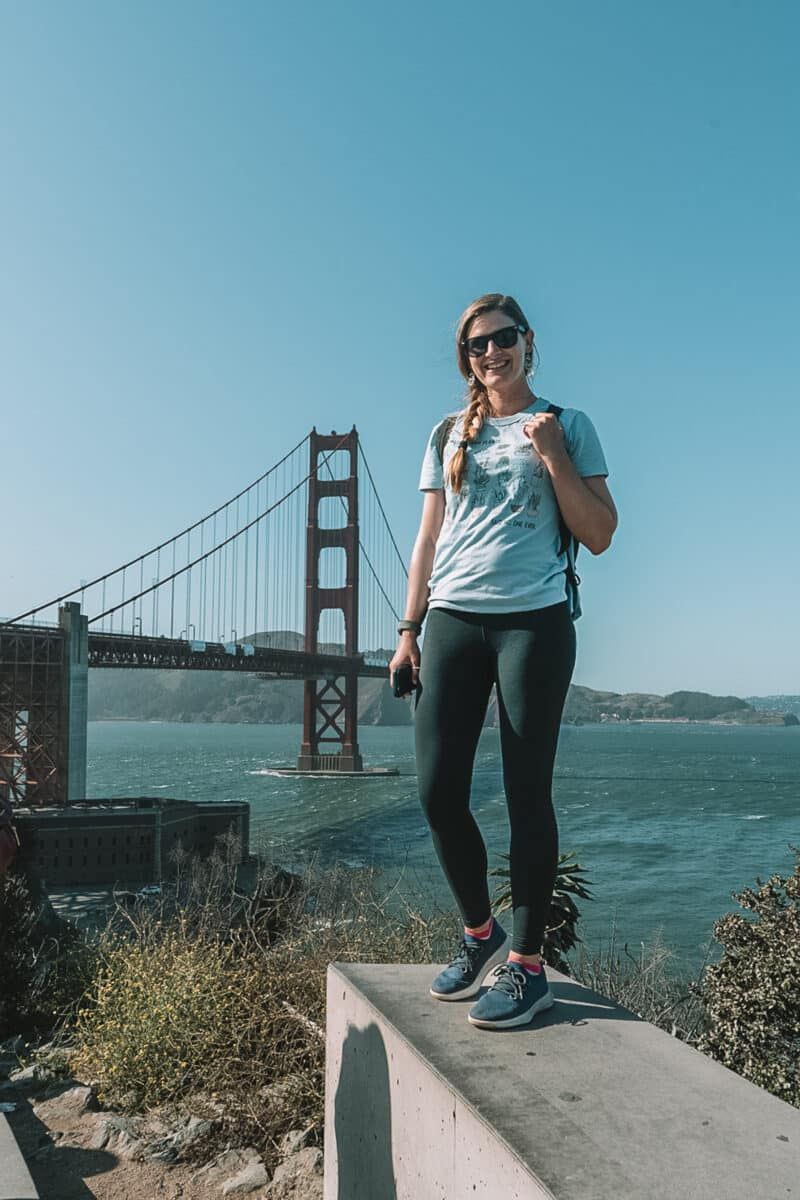
Get your FREE California Travel Planner – including printable checklists and my favorite two-week itinerary for the state.
Golden Gate Bridge Walk: Practical Info & What to Expect
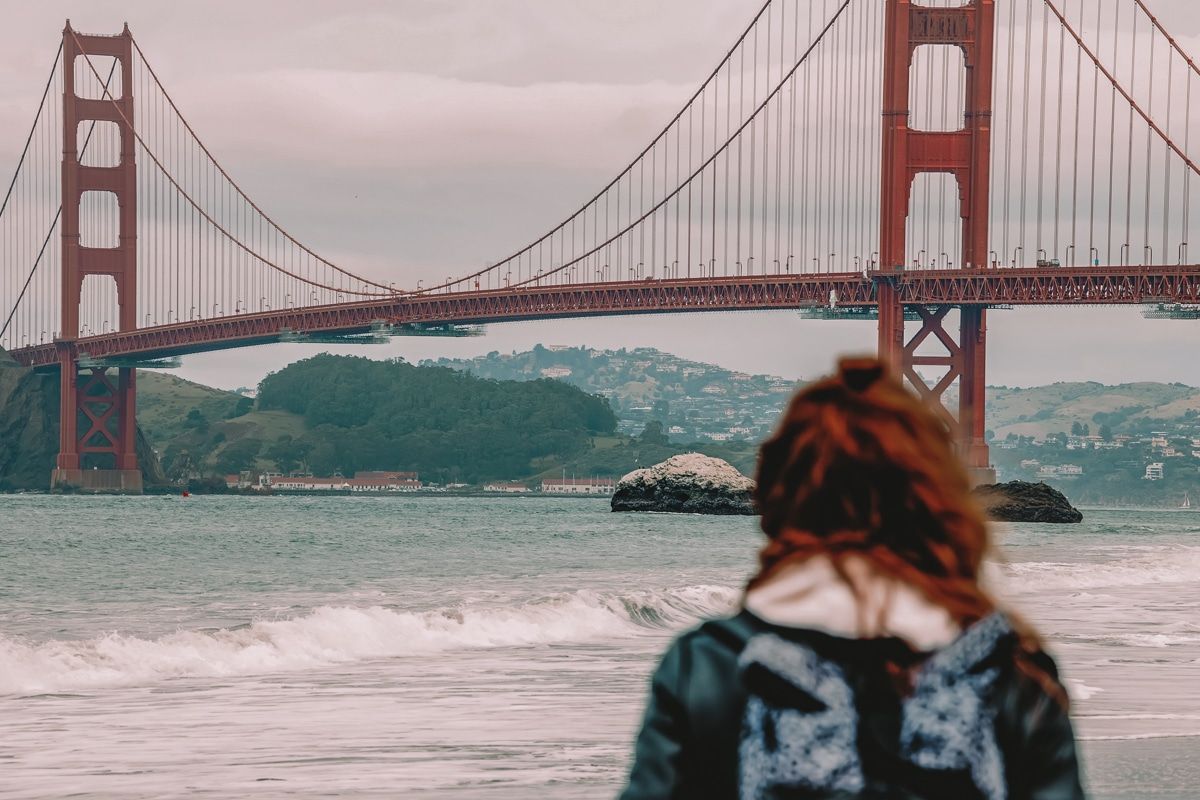
There is a pedestrian walkway running along the east side of the bridge. To get there, you will need to find the south side entrance from the Golden Gate Bridge Welcome Center parking lot.
On the north end of the span, the pedestrian entrance is in the Vista Point parking lot.
There’s no charge to walk across the bridge– it’s free for pedestrians and cyclists. However, the walkway is not open 24 hours a day.
Pedestrians can cross during daylight hours. So, from November to early March, the bridge is open to pedestrians daily from 5 a.m. to 6.30 p.m.
During Daylight Savings Time, the bridge is open to pedestrians on weekdays from 5 a.m. to 8 p.m. and on weekends from 5 a.m. to 9 p.m.
Personally, I would love to walk across the bridge at night, but it’s considered too dangerous for foot traffic after dark.
If you’re starting your trip across the bridge later in the afternoon, ensure you have enough time to return before the gate closes.
Another important note: dogs are not allowed to walk across the bridge unless they are service dogs. You are also not permitted to ride an electric scooter, use rollerblades or a skateboard, or push a wheelbarrow (I suspect someone must have tried this at some point).
There’s nothing in the rules against taking a stroller, however.
Fog is typical around the bridge, and it gets windy up there, so dress accordingly. Light layers, like a fleece or a waterproof jacket, are a must in San Francisco.
Walking the Golden Gate Bridge: How to do it & Routes
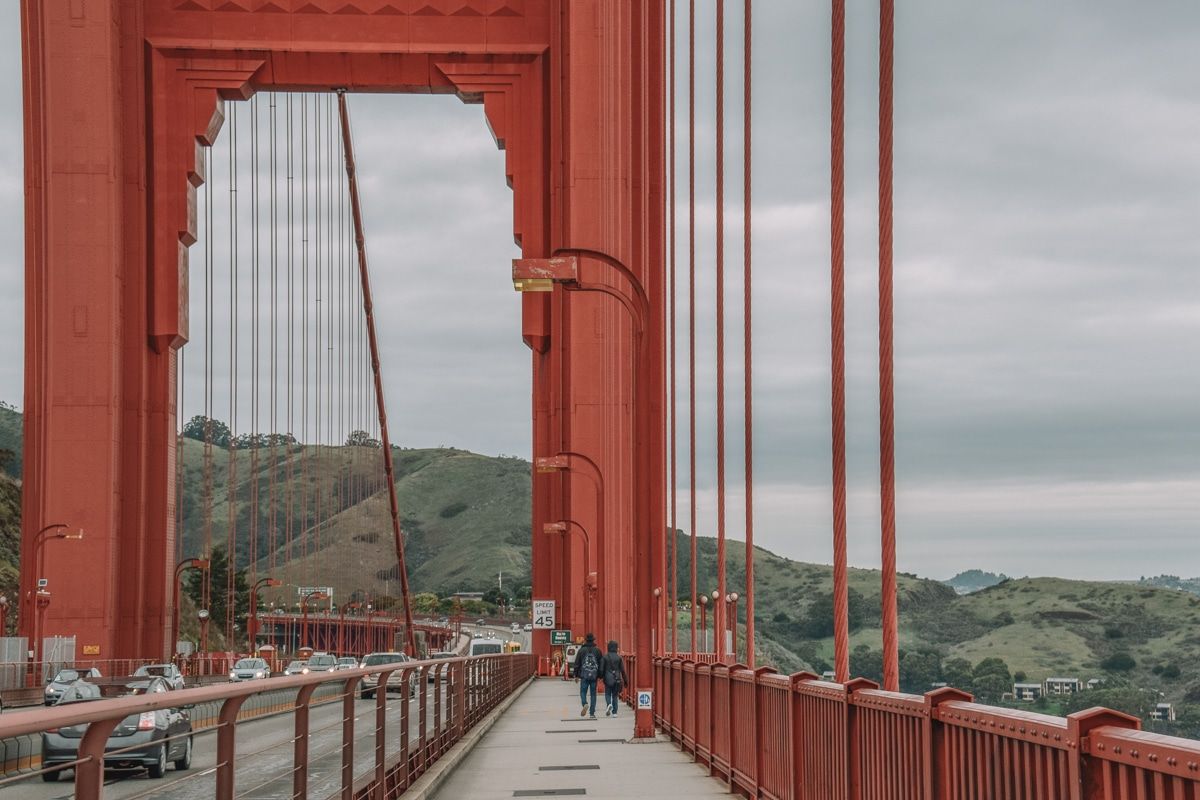
You can choose from several routes to cross the bridge, depending on how much walking you want to do.
The shortest and most straightforward way is an out-and-back trek from the Golden Gate Bridge Welcome Center on the San Francisco side to the North Vista Point in Marin, then back again.
Although you can, of course, do any of these routes from the north end, there are a couple of advantages of starting from San Francisco.
The first is the parking situation. You’ll find plenty of parking areas and public transit options in the city.
The second is the snack situation: there are no cafes on the north side, and it’s nice to end with a coffee.
Welcome Center to the North Vista Point
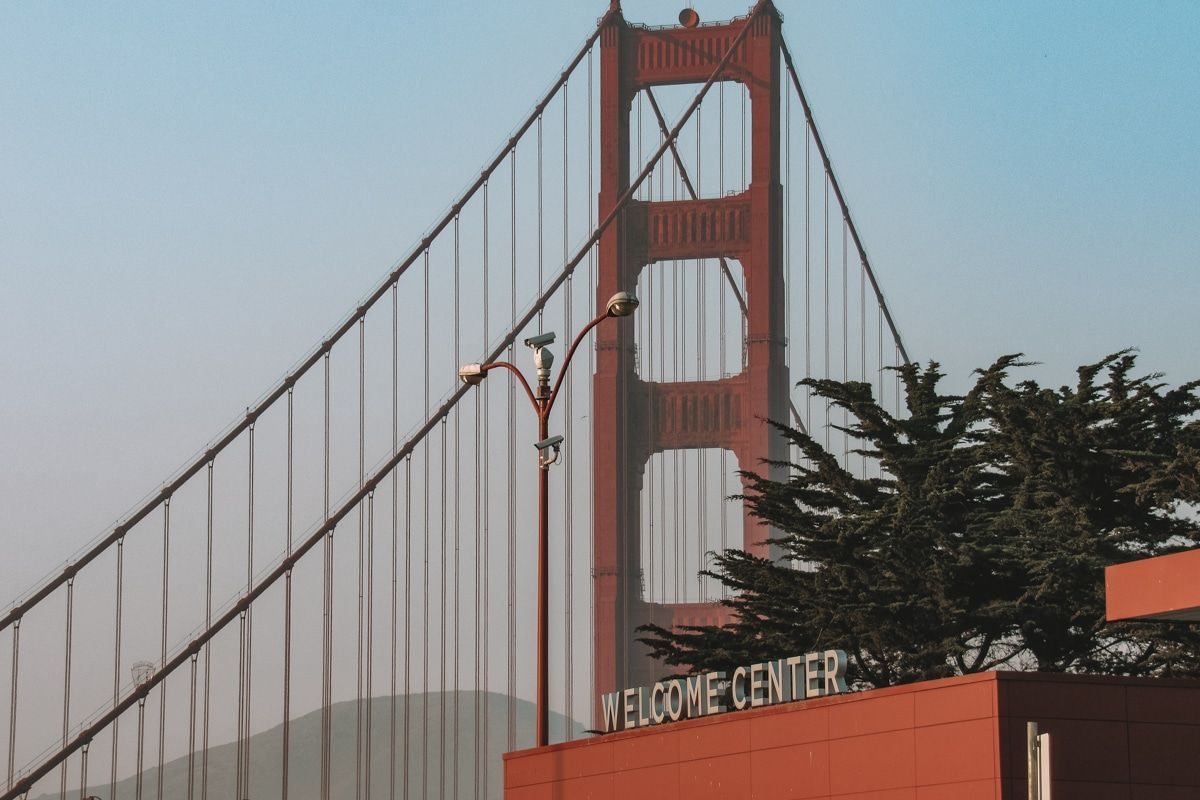
To get to the pedestrian gate on the southern (San Francisco) side of the bridge, head to the Welcome Center. If you’re feeling turned around, you can pull up a google map to situate yourself.
If you have time, spend a few minutes learning more about the famous structure there. At the time of its construction, it was the longest and tallest in the world, with many groundbreaking features.
While you’re there, check out the statue of Joseph Strauss, the chief engineer credited with designing the bridge.
Just behind the visitor center is the Round House, a coffee shop whose floor-to-ceiling windows offer fantastic bridge views.
Outside the coffee shop is the perfect spot for taking photos of the bridge– the Golden Gate Bridge Vista Point South.
From the vista point, you should be able to see the east side entrance gate. Head through the gate and start your walk along the east sidewalk across the bridge.
Along the way, look out for the island of Alcatraz, the Marin headlands ahead of you, and downtown San Francisco behind you.
Also, check out the bridge itself– by walking, you’re in a much better position to check out the beautiful art deco architectural features the motorists miss. Look out for the chevrons on the tower struts, concrete pylons, curvy lamposts, and round uplights.
On the first tower, the south tower on the San Francisco side, you will also spot a commemorative plaque naming the engineers and politicians who helped construct the bridge.
At the northern end of the bridge, exit at the north gate on the Marin County side for the North Vista Point, where you will get one of the best views of the bridge, with San Francisco in the background.
Once you’ve marveled at the view, head back over the bridge the way you came.
Welcome Center to Sausalito
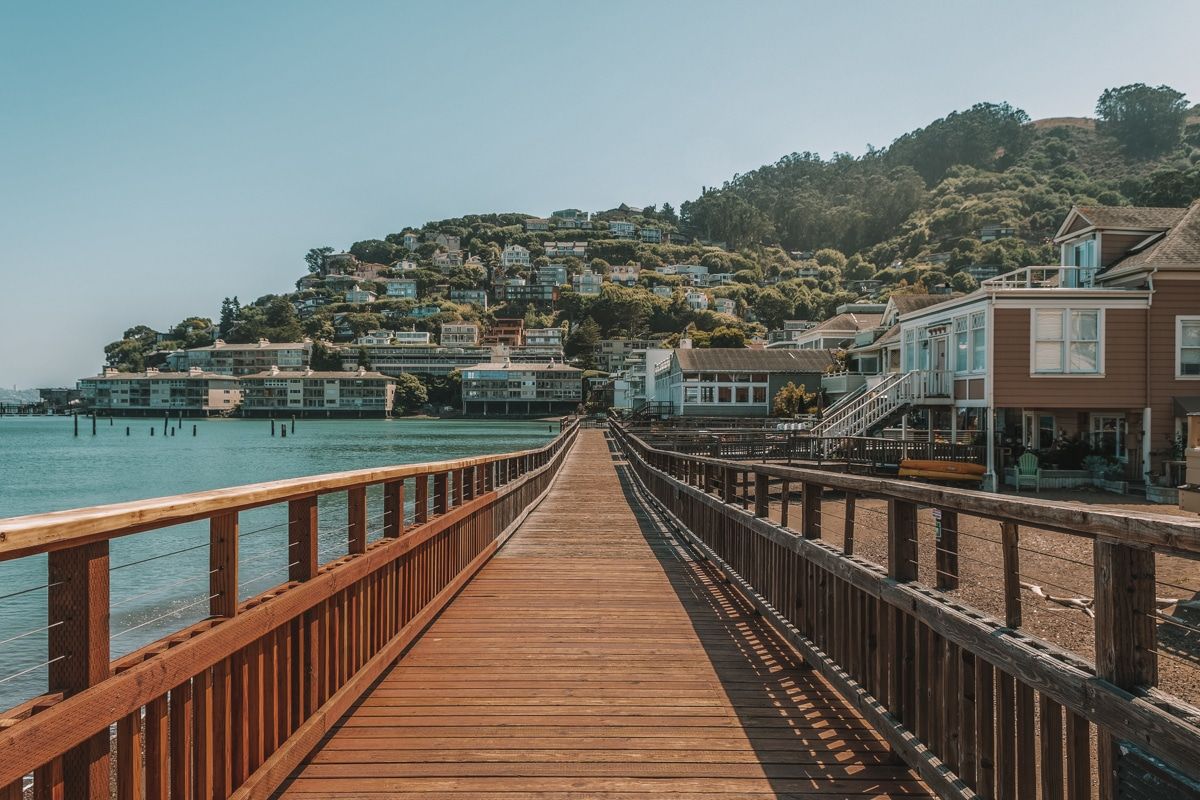
Another great route (my favorite) is to walk across the Golden Gate Bridge and take a ferry back.
Going on a San Francisco ferry is the best way to see San Francisco Bay. Plus, you’ll view the bridge from another perspective.
Start from the south end at the Welcome Center and cross the bridge, as described in the above section.
Once you get to the other side, you’ll reach North Vista Point in the Marin headlands, an excellent spot for taking photos of the bridge. To continue into Sausalito, walk through the pedestrian tunnel that connects to Conzelman Road Parking Lot.
From here, look for the Bay Trail at the corner of the lot. You’ll see a sign for Fort Baker and Sausalito. This trail is for pedestrians and cyclists, so it’s a safe and pleasant walk.
This walking path will take you down to Fort Baker, a former U.S. Army post with over 25 historic buildings. It’s an interesting place to explore if you don’t have a tight time limit.
Follow the Bay Trail along East Road, then continue along Alexander Avenue until you hit downtown Sausalito. As long as you keep the water on your right, you can’t go wrong on this route.
Sausalito is a Bay Area gem. Not only is it full of great restaurants, cafes, art galleries, and boutique shops, but it’s also usually sunnier than San Francisco.
With the pretty houses dotting the green hills, it feels like you’ve crossed into Italy instead of Marin.
After lunch, stroll down to the ferry terminal and return to San Francisco. On the trip back, you’ll catch great views of Alcatraz, Angel Island, and San Francisco, as well as the bridge itself.
This route involves about five miles of walking plus the ferry ride back, so allow plenty of time for this trip.
Walking the Golden Gate Bridge from Sausalito is an option, but you will have a hill to climb in this direction.
Batteries to Bluffs Trail
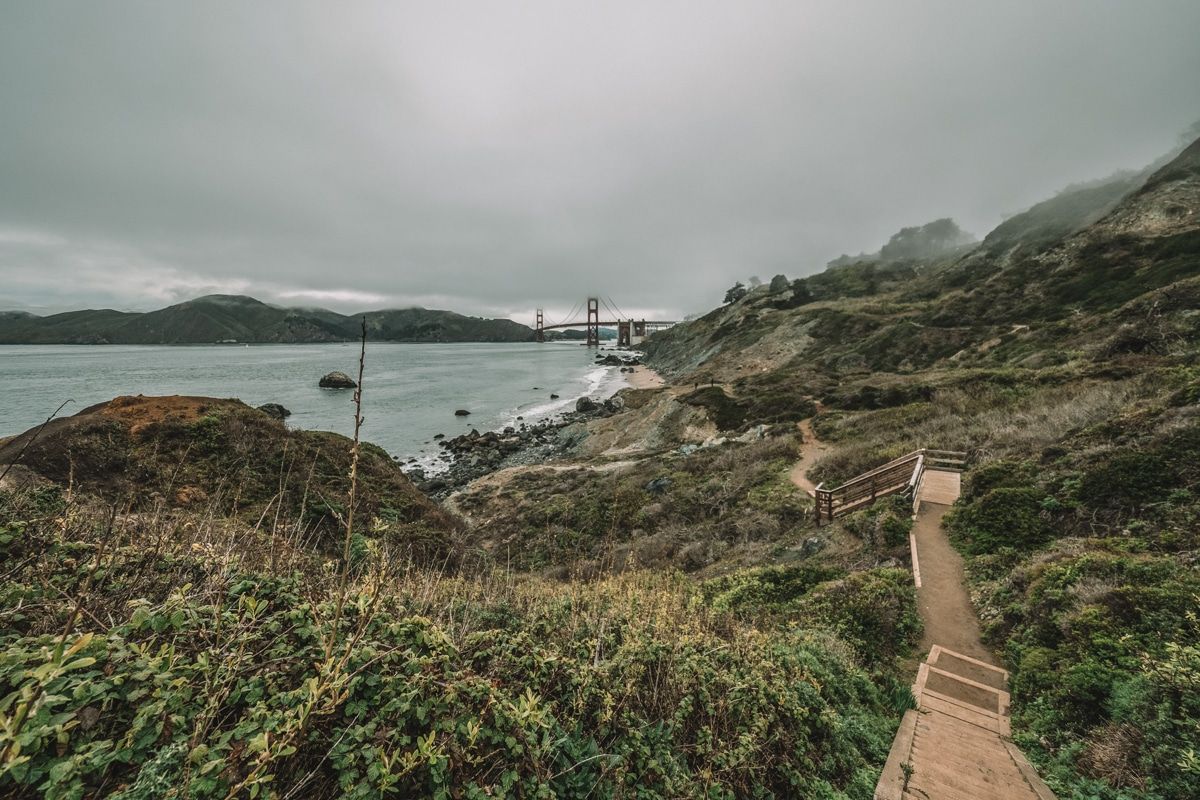
Stretch your legs on the San Francisco side of the bridge by hiking through the stunning Presidio on the Batteries to Bluffs Trail.
Start at Baker Beach, which has a car park with free parking. This broad, sandy beach is popular with families and dog walkers. With the Marin headlands in the background, you’ll also get a pretty Golden Gate Bridge viewpoint.
From here, take the Batteries to Bluffs trail east. You’ll get views of the ocean and the crumbling military outposts lining the cliffs. There’s also another nice vista point to see the bridge along the way.
Follow the trail to the Welcome Center, then take the entrance to the bridge to continue over to Marin along the pedestrian walkway.
This option will add about two miles to the hike if you end the walk in the same place you began.
Crissy Fields on the Battery East Trail
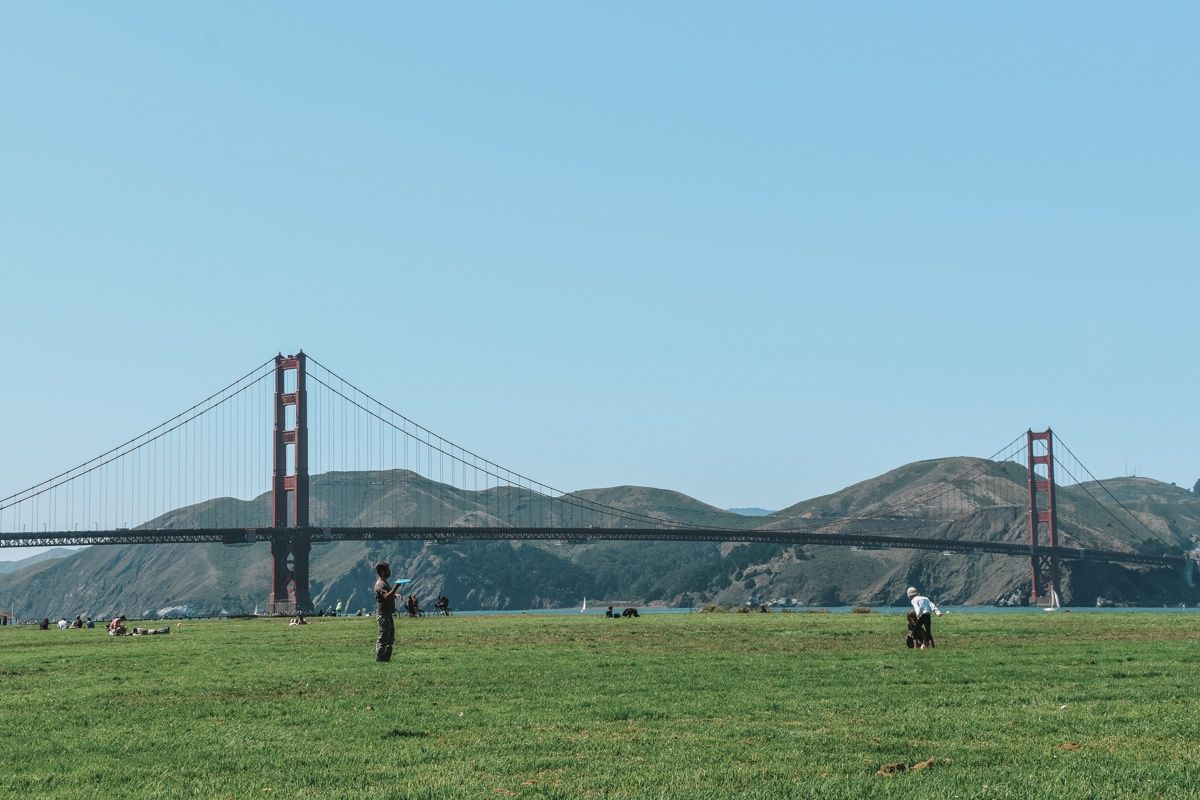
The Batteries to Bluffs trail takes you around the peninsula’s west side, but you can also hike around the east side on the Battery East Trail from Crissy Fields.
Once an airfield, Crissy Fields is now a waterfront park, perfect for picnics, kite flying, and strolling. Take the Battery East Trail from the Warming Hut, a National Parks-run cafe and gift shop.
Head to the Welcome Center before continuing across the bridge. This route will add half a mile to your bridge walk. If you want to go a little further, take a detour to Fort Point.
Designated as a National Historic Site, Fort Point is a civil war-ear military post that sits under the southern end of the San Francisco bridge.
Walking Distance of the Golden Gate Bridge
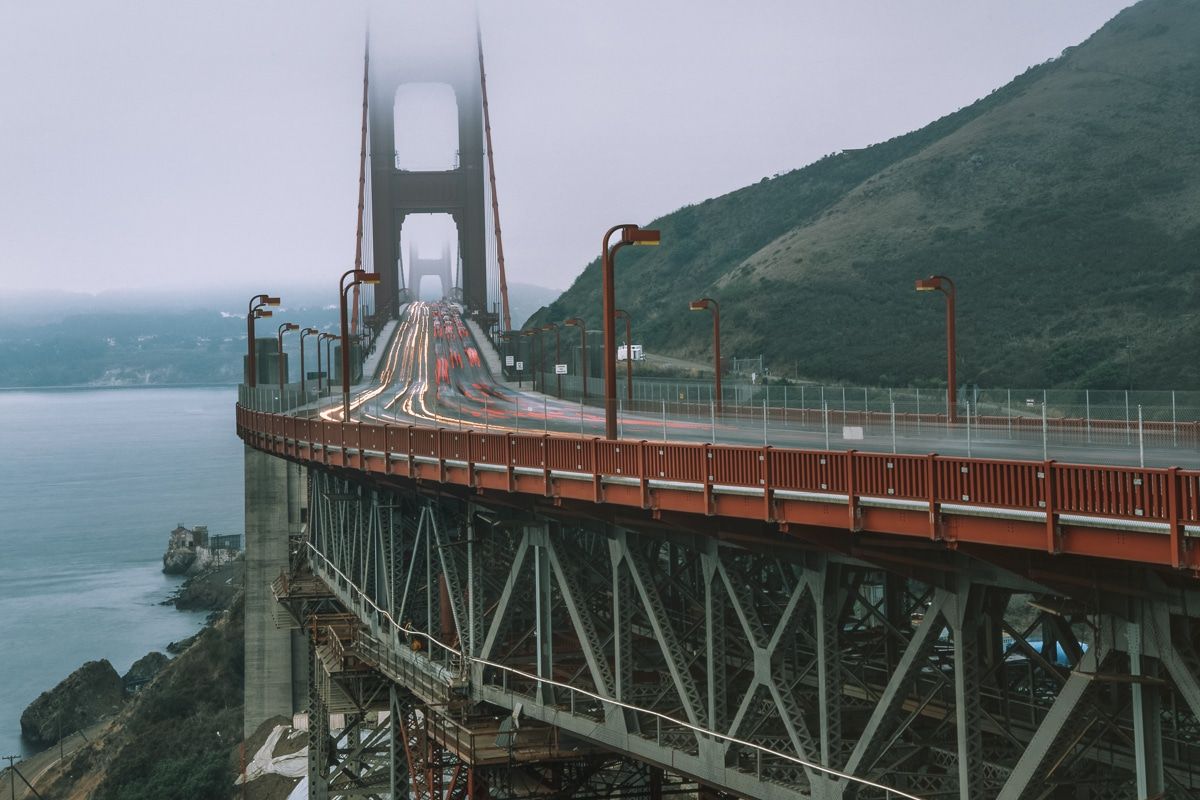
The walking distance from the Welcome Center at the south end of the bridge to the North Vista Point exit in Marin is 1.7 miles long.
At a steady pace, this route will take between 30 and 40 minutes. But, if you’re stopping for photos regularly, expect the walk to take somewhat longer.
Best Time of Day to Walk Across the Golden Gate Bridge
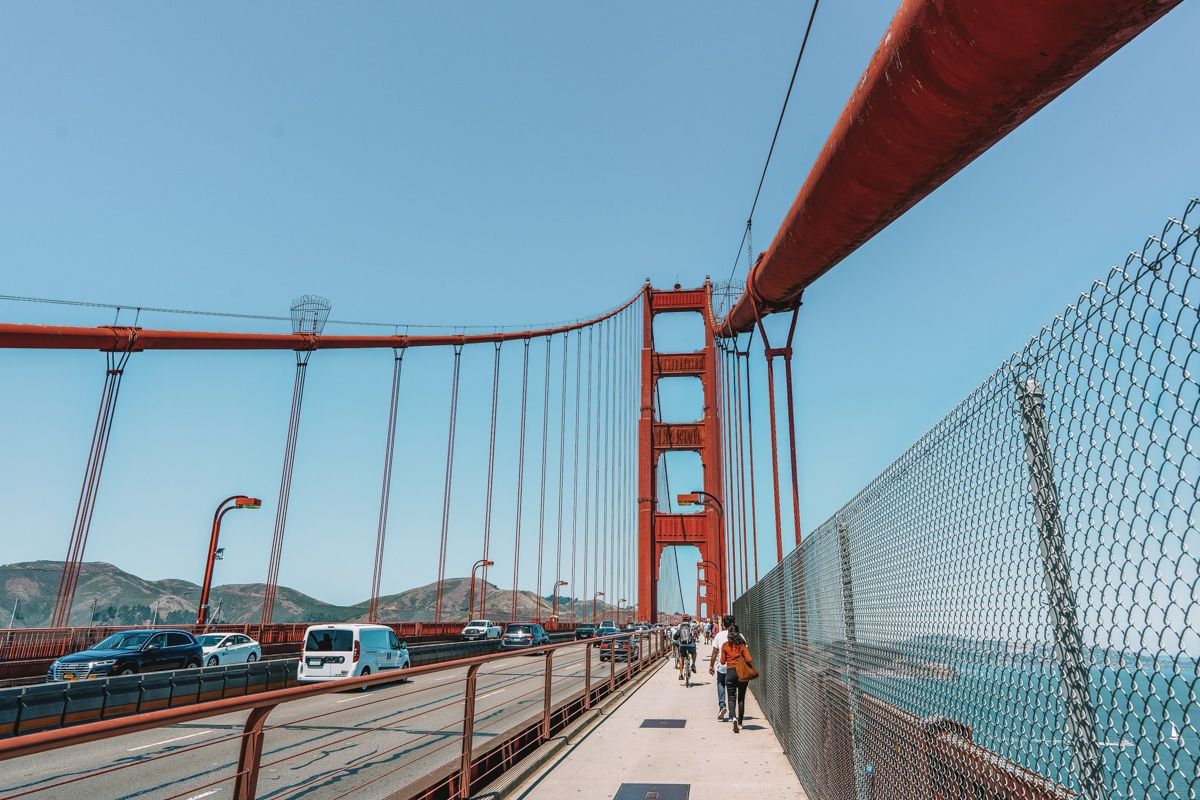
The best time of day for walking on the bridge is in the early afternoons when the fog burns off, and the sun breaks through.
On weekdays, cyclists may use the east sidewalk until 3.30 p.m., so aim to cross after this time if you don’t want to share the pathway with bikes.
The east side is pedestrian-only during weekends and holidays, but these are more popular times to visit, so expect crowds.
If you cross later in the afternoon, make sure you have a plan for getting back, as the gates close at dusk.
Summer is the peak tourist season and also the peak fog season. September and October are the best months for visiting San Francisco because they offer the nicest weather and fewer crowds.
Where to Park for Walking Over the Golden Gate Bridge
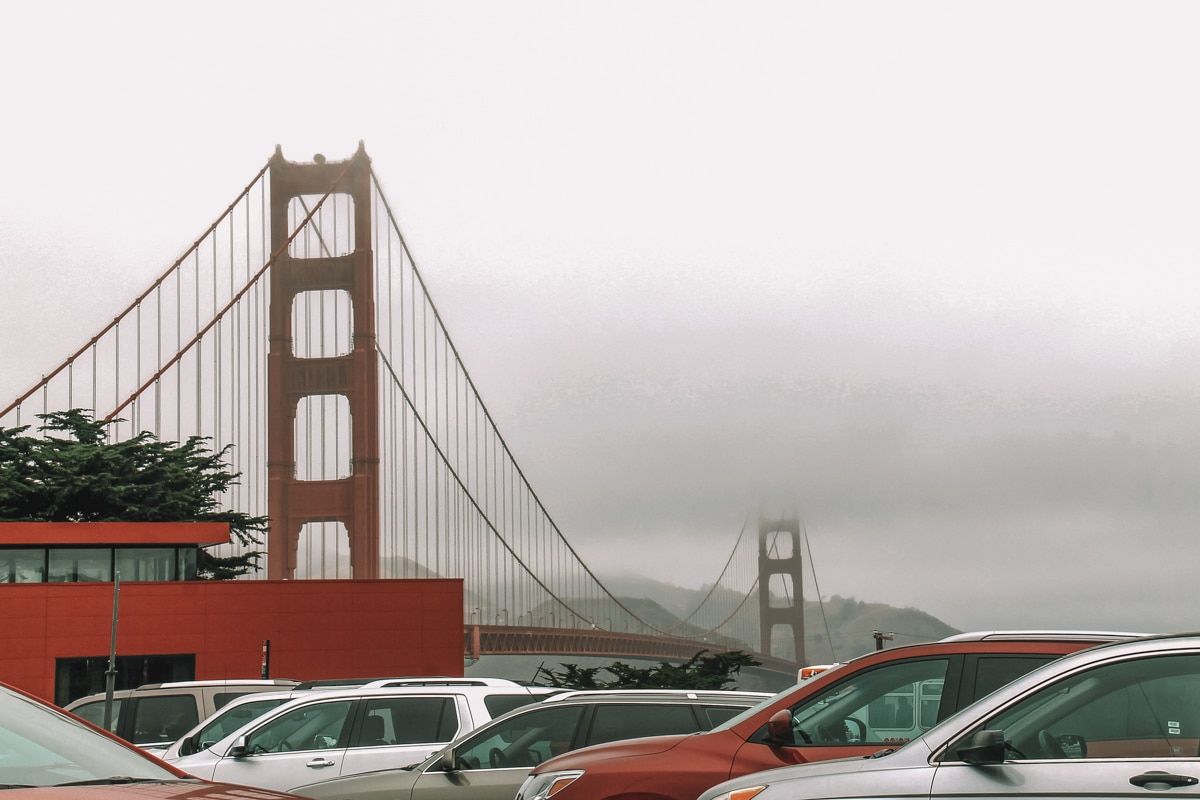
Finding Golden Gate Bridge parking can be challenging, but you can use nearby parking lots.
The Welcome Center has a small parking lot, which fills up quickly. Finding a parking space will be difficult unless you arrive early. Parking spots cost $5 an hour, up to a maximum of three hours.
The Presidio also has plenty of parking options, mostly pay and display, although you may find some free spots.
A sizeable lot runs alongside the Main Parade Lawn, plus on-street areas on Montgomery St. and the surrounding roads.
It’s a 30-minute walk from the Presidio to the Welcome Center or a 15-minute walk to Richardson Ave., where you can jump on a 28 at one of the bus stops.
Closer parking lots to the bridge are available within the Presidio at 6302 Merchant Rd. and at Battery East, off Lincoln Blvd. These lots are also small but slightly less known than the Welcome Center parking.
Parking at Battery East costs $1.60 an hour (rising to $3 an hour from April 2023) or $10 for a daily pass. These lots are a five-minute walk from the Welcome Center. Another small parking lot at Fort Point is at the end of Marine Drive. It’s free, but the spaces are limited.
If you plan to walk across the Golden Gate Bridge from the Marin side, there are two lots available, both small.
One lot is at North Vista Point. The other is across the other side of the bridge at Conzelman Road, and a pedestrian tunnel connects the two lots. Currently, parking there is free but may rise to $3 an hour in 2023.
How to Get to the Golden Gate Bridge Without a Car
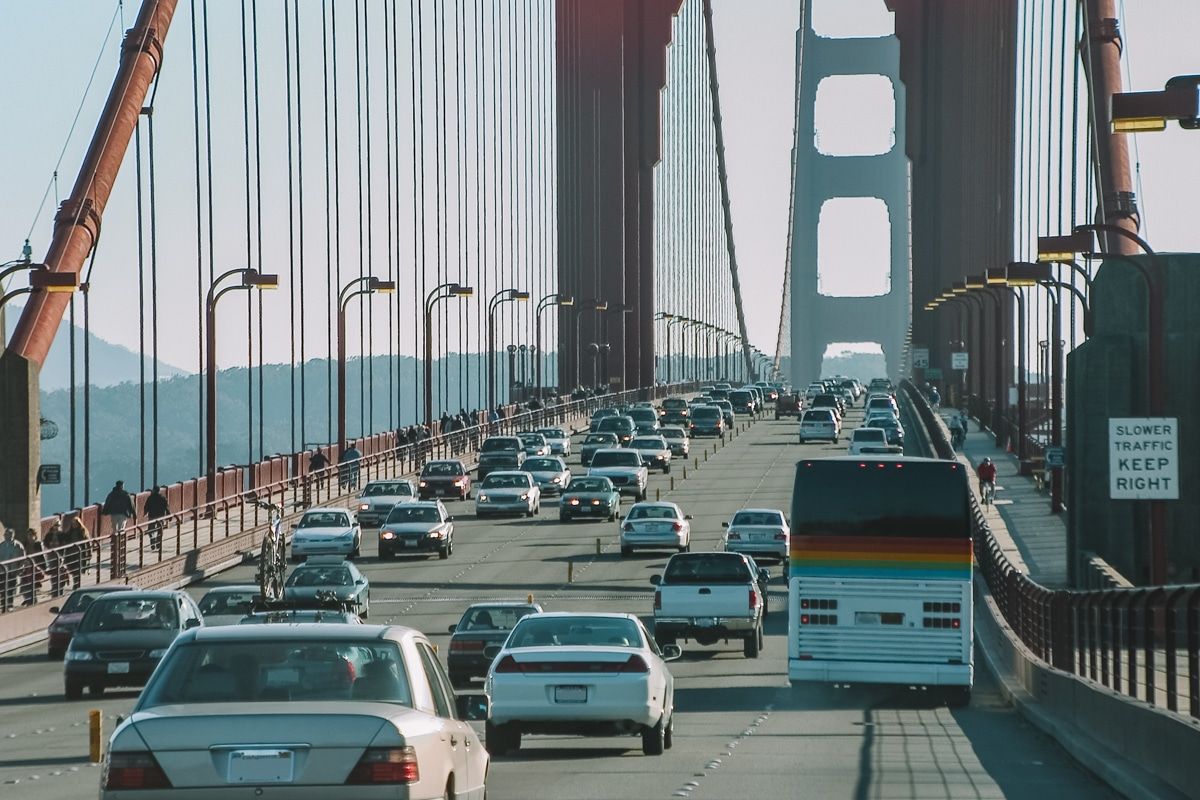
There are several ways to get to the bridge without a car. You can use public transit, rent a bicycle, or take a taxi.
Public transit options
From Fisherman’s Wharf, you can take the 28 bus to the Toll Plaza, which will take about 25 minutes.
If you are coming from the Embarcadero, hop on the free PresidiGo shuttle to Richardson Ave., where you can change for the number 28 city bus.
A fun way to get to the bridge from Union Square and Civic Center is to jump on the Hyde/Powell historic cable car to Fisherman’s Wharf before changing for the 28 Muni.
Alternatively, Muni routes 101, 130, and 150 will take you from Union Square to the Golden Gate Bridge Toll Plaza.
If you want to cross the bridge by bus one way, you need to board the Golden Gate Transit Bus (GGT). Take GGT Route 130 bus at Salesforce Transit Center near Union Square, which will stop on the north side of the bridge.
Rent a bicycle
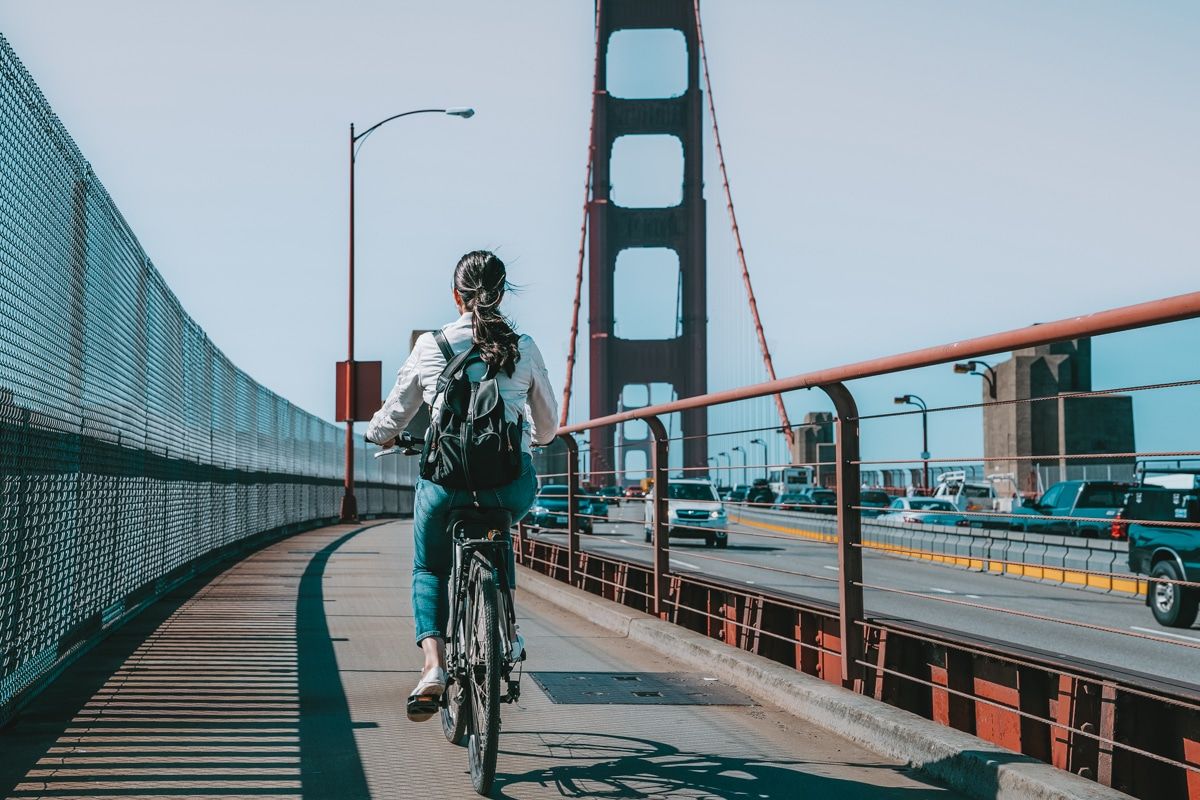
Rent a bicycle and cycle from the Embarcaderoto to the bridge along the bay. Most of the way is car-free and relatively flat for San Francisco.
If you rent bikes from Golden Gate Bridge bike rentals, you will receive a helmet, bike lock, and basket– everything you need for a bike ride through the city.
Once you get to the bridge, store your bike at one of the bike racks at the Toll Plaza bus stop. Or keep going and cycle across the bridge– stick to the west sidewalk if it’s a weekend or after 3.30 p.m. on a weekday.
Take an Uber/Lyft/taxi
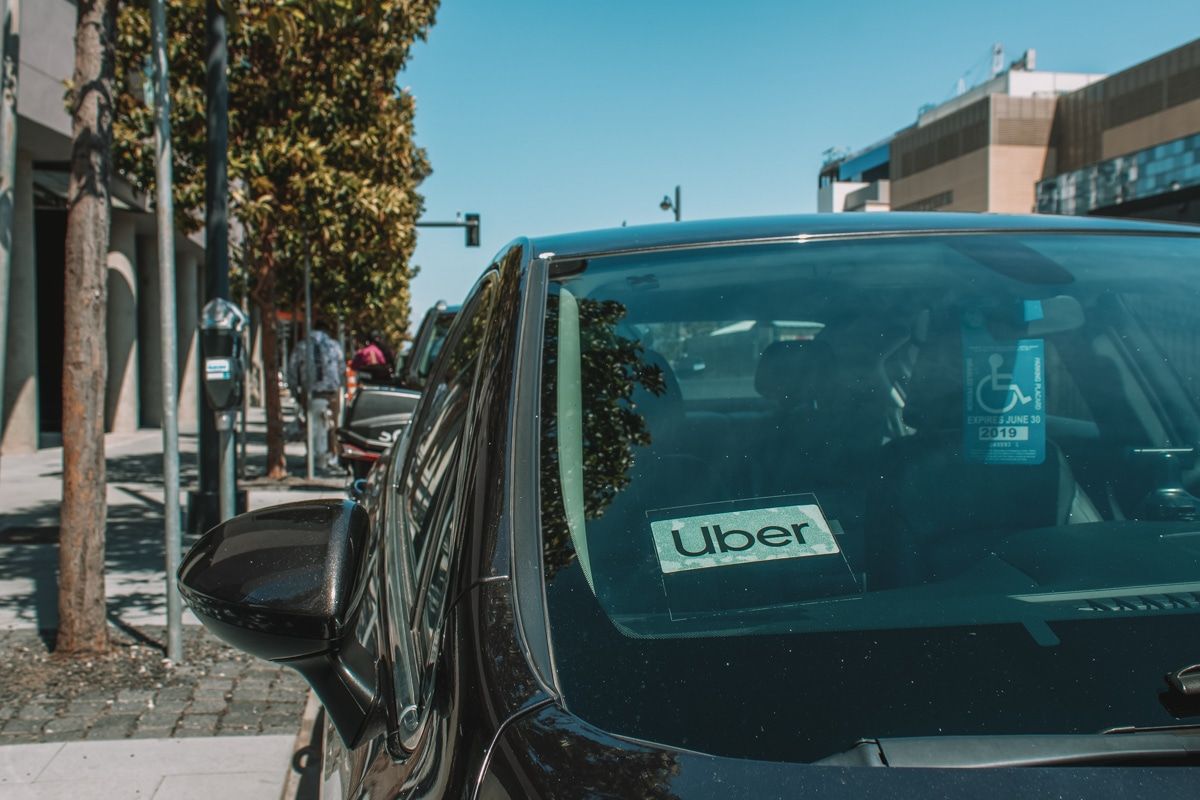
There are plenty of Ubers, Lyfts, and taxis throughout San Francisco. It’s easy to hail a ride to the Welcome Center.
If you want to walk across the bridge from the south end and catch an Uber back, be mindful that cars can only access northbound North Vista Point.
In other words, a driver from the Marin County side would have to drive to San Francisco, turn around and drive back across to you.
Save some time by walking over to the Conzelman parking lot on the other side of the bridge and have the driver pick you up from there.
Bear in mind that although you can no longer pay in cash at the toll booth, there is a fee for crossing into San Francisco by car, which will be included in your fare.
Best Walking Tours of the Golden Gate Bridge
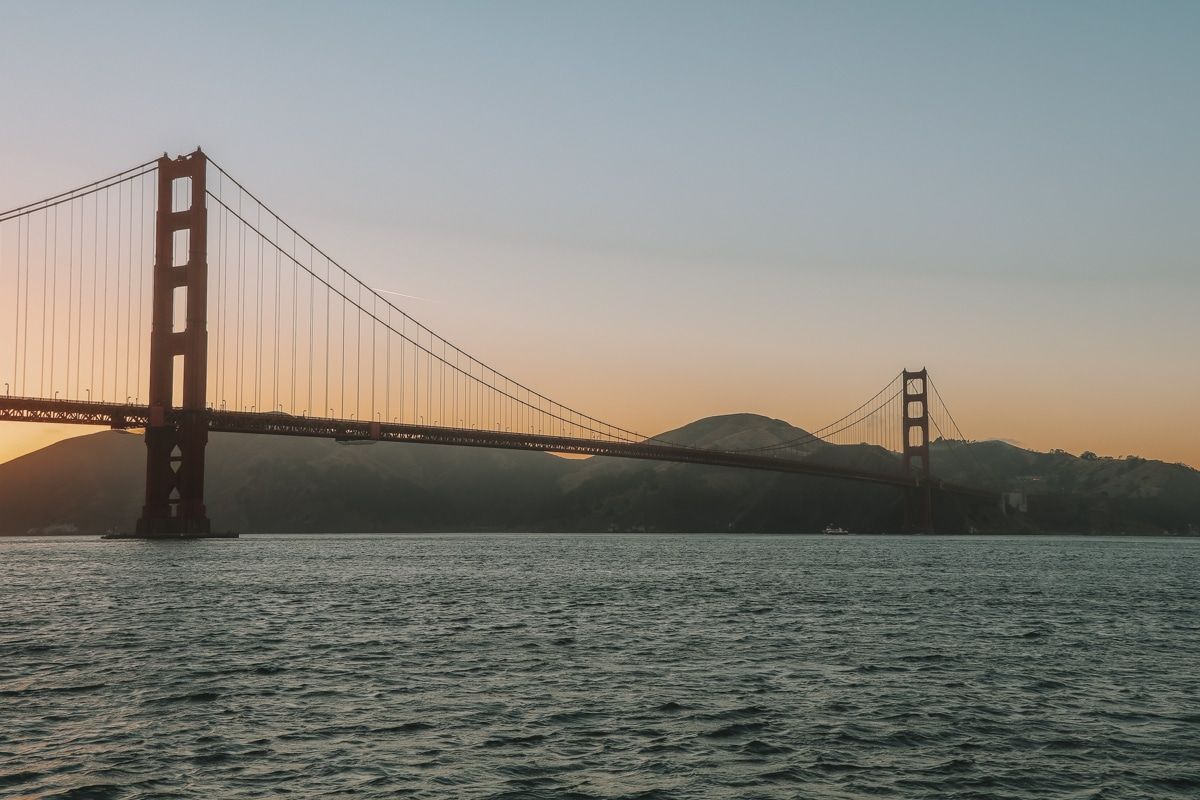
Take a free walking tour to discover the history of this beautiful bridge with SF City Guides.
This non-profit organization, with roots in the San Francisco City Library, proudly gives tours around the city to visitors and locals alike.
San Francisco City Guides tours are free, but they suggest a $20 donation. Check out the website for tour times.
Other Tours of the Golden Gate Bridge

A bike tour is a great way to experience the bridge. Let an experienced guide take you over the bridge and into Sausalito, then bike back or take the ferry.
This Golden Gate Bridge tour includes a full day of bike rental, so there’s plenty of time to hang out in beautiful Sausalito after your adventure.
After you’ve walked across the entire bridge, the logical thing to do is take a boat cruise underneath.
This San Francisco bay cruise takes guests under the bridge, past Alcatraz and Angel Island, and offers breathtaking views of the Marin headlands.
Another great way to experience the bridge is to take a Big Bus Hop-on, Hop-off tour. This bus stops at both the Welcome Center and the North Vista Point, so you can walk across and ride back, or vice versa.
Walking the Golden Gate Bridge at Night
It would be cool to do the walk at night, but unfortunately, the walkway closes after sunset. After dark, you would have to drive or take public transportation to get across.
For other things to do in San Francisco at night, check out our full guide!
Tips for Walking Across the Golden Gate Bridge
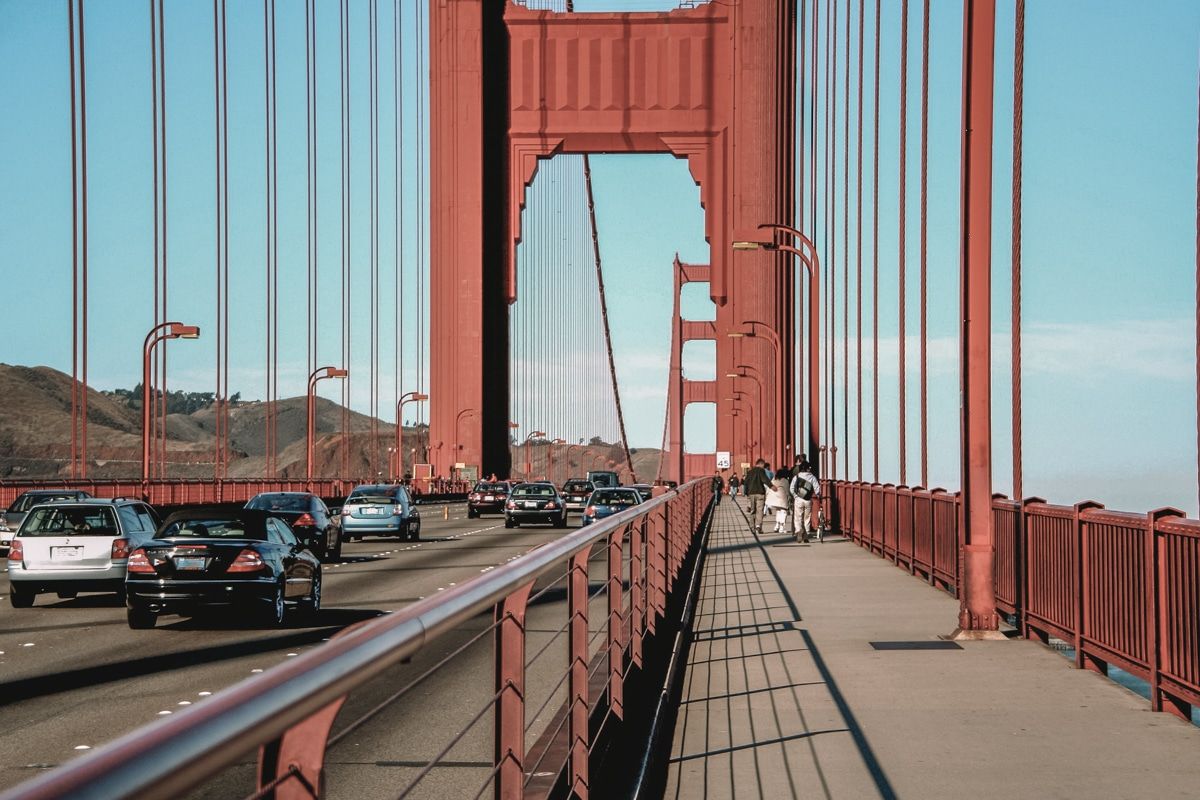
- Wear a jacket– it may be warm in the Mission but freezing on the bridge.
- If you take the Hop on Hop Off tour, you can walk across the bridge and take the bus back from the Marin side.
- Grab a coffee and souvenir from The Warming Hut at Crissy Fields, Equator Coffee at the Round House Cafe, or the Golden Gate Bridge Cafe. You’ll also find great food trucks at the Presidio on weekends. There is no snack bar at the northern end of the bridge.
- If you go midweek, wait until after 3.30 p.m., when cyclists no longer use the path.
- Comfortable shoes are a must; it’s over a three-mile round trip with hills. Wearing heels is a bad idea.
FAQs About Walking Across the Golden Gate Bridge
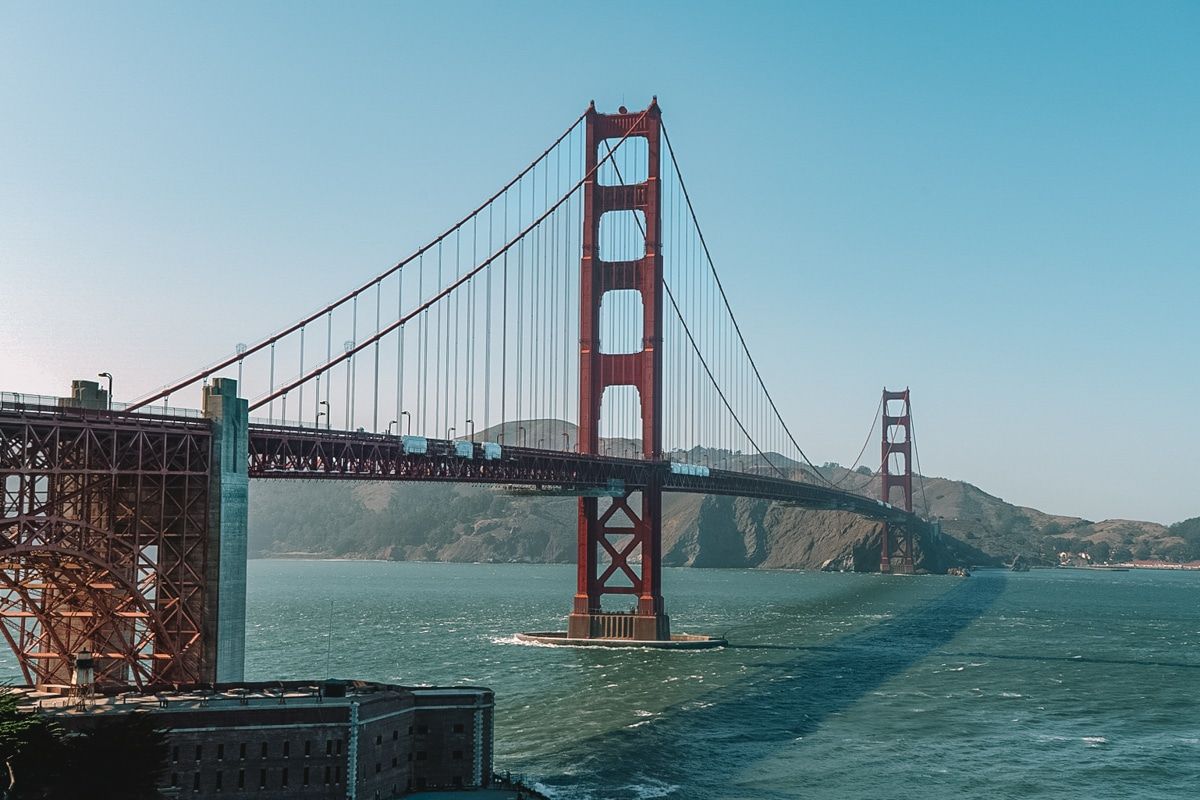
How long does it take to walk the Golden Gate Bridge?
Plan for 30-40 minutes each way. It will take longer if you frequently stop for photos!
How many miles long is the Golden Gate Bridge?
The bridge is 1.7 miles long.
How much does it cost to walk on the Golden Gate Bridge?
It’s free to walk or cycle across the bridge, and there is a toll for driving across the bridge from Marin to San Francisco, which ranges from around $8-$9 for most personal vehicles.
Where do you start to walk the Golden Gate Bridge?
Pedestrians use the east sidewalk. You will find the entrance behind the Golden Gate Bridge Welcome Center on the San Francisco side or from the parking lot at North Vista Point on the Marin side.
Is the Golden Gate Bridge open for walking? Are there pedestrian hours?
The bridge is open to walkers all year round, during daylight hours. From early November to early March, the bridge is open to pedestrians from 5 a.m. to 6.30 p.m.
During Daylight Savings Time, the bridge is open to pedestrians on weekdays from 5 a.m. to 8 p.m. and on weekends from 5 a.m. to 9 p.m.
Can you walk the Golden Gate Bridge at night?
Unfortunately not, the pedestrian gates are closed at night.
What is the best way to view the Golden Gate Bridge?
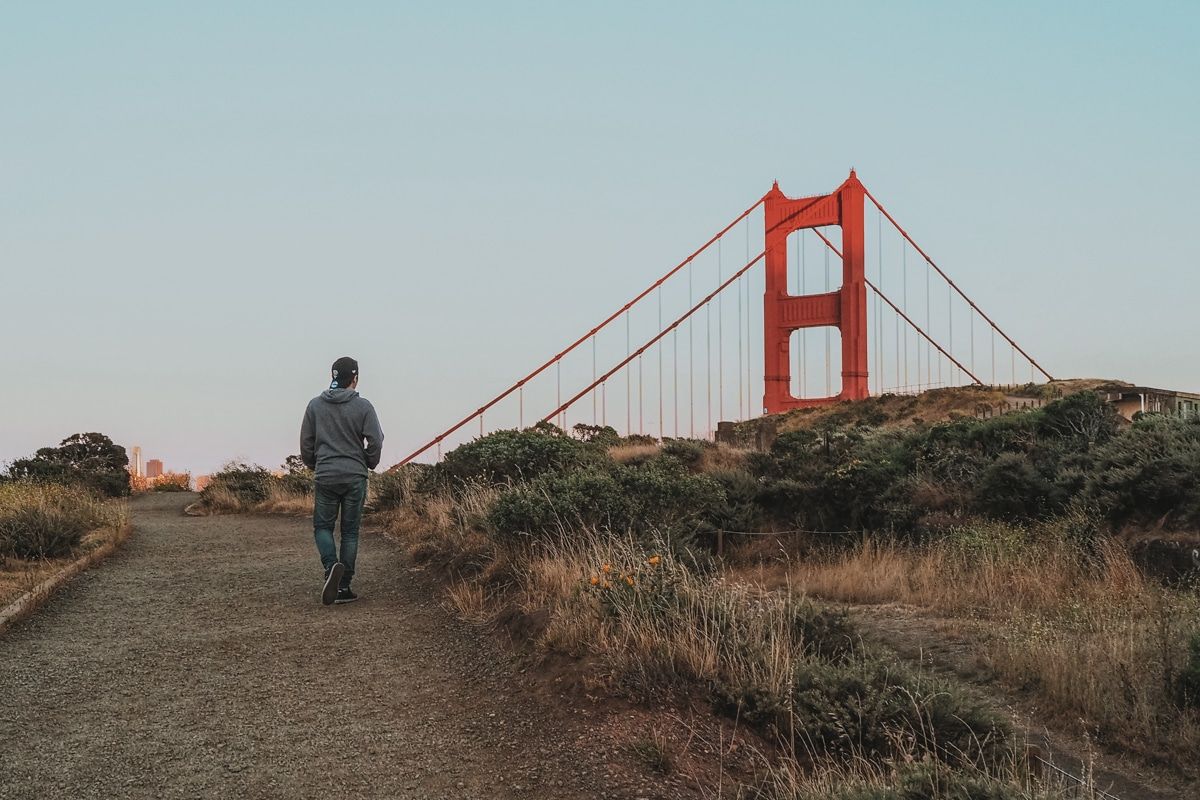
There are so many ways to enjoy an amazing view of the bridge!
Hike out to an incredible vista point, eat at a restaurant with a view, take a sunset catamaran cruise under the bridge, a helicopter ride over the bridge, or simply walk across the Golden Gate Bridge.
How do you get across the Golden Gate Bridge without a car?
You can get across the Golden Gate Bridge on foot, on a bicycle, or even roller blades. You can also travel by public transport, in a taxi or rideshare, or on a Hop on, Hop off tour bus.
When is the best time to see the Golden Gate Bridge? How can you see the Golden Gate Bridge without fog?
The best time to see the Golden Gate Bridge is in the afternoon when you have the best chance of seeing it without the fog. However, there’s never a guarantee that the fog won’t make an appearance.
Are dogs allowed on the Golden Gate Bridge?
You are not allowed to walk a dog on the Golden Gate Bridge unless you are walking a service dog.
Are there bathrooms on the Golden Gate Bridge?
There are bathrooms at both ends of the Golden Gate Bridge, the Welcome Center at the south end, and the North Vista parking lot at the north end. There are no bathrooms on the bridge itself.
ABOUT THE AUTHOR

Sarah McDonald
Sarah McDonald is a travel writer based in the Bay Area. She writes for the national parenting website Red Tricycle and on her own family travel blog, Tiny Trailblazers. She loves exploring California’s outdoors and has a weakness for a national park gift shop.
Sarah enjoys sharing her Bay Area expertise with readers curious to try popular restaurants and off-the-beaten-path adventures in California. When she’s not writing reviews and travel guides, you’ll likely find her trying to keep up with her kids on a hiking trail or deciphering the menu at a new restaurant.
Looking for more San Francisco travel tips? Check out these related articles below!
Best Thrift Stores in San Francisco
Where to See Redwoods Near San Francisco
Outdoor Date Ideas in the Bay Area
Best Bakeries in San Francisco
Things to do in Fisherman’s Wharf
A Guide to Cable Cars in San Francisco
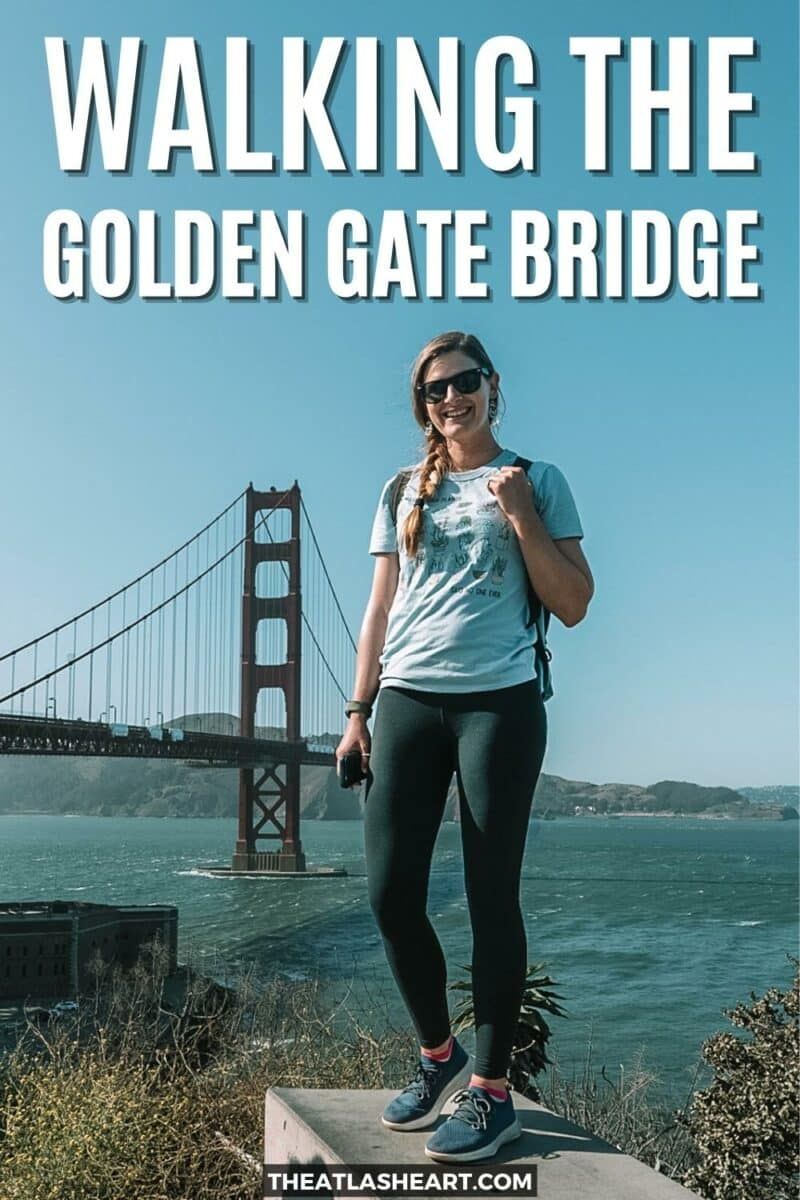
Pin this image for future reference

